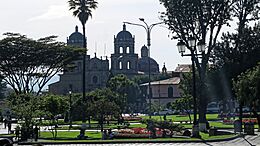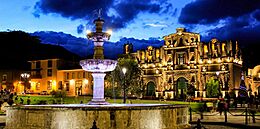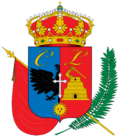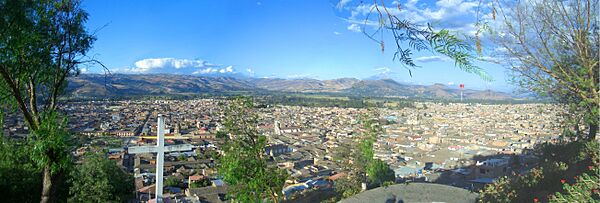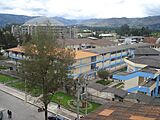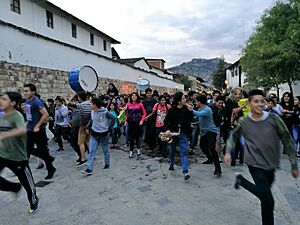Cajamarca facts for kids
Quick facts for kids
Cajamarca
|
|||
|---|---|---|---|
|
Clockwise from top: Partial view of the city, Nuestra Señora de la Piedad Church, Santa Catalina Church, Main Square, Los Baños del Inca and Ventanillas de Otuzco.
|
|||
|
|||
| Country | |||
| Region | Cajamarca | ||
| Province | Cajamarca | ||
| Founded | c. 1320 by pre-Columbian ethnic groups Spanish settlement in 1532 |
||
| Area | |||
| • Total | 392.47 km2 (151.53 sq mi) | ||
| Elevation | 2,750 m (9,020 ft) | ||
| Population
(2017)
|
|||
| • Total | 201,329 | ||
| • Estimate
(2020)
|
245,137 | ||
| • Density | 512.979/km2 (1,328.610/sq mi) | ||
| Demonym(s) | Cajamarquino/a | ||
| Time zone | UTC-5 (PET) | ||
| Area code(s) | 76 | ||
| Website | municaj.gob.pe | ||
Cajamarca (pronounced kaha-MAR-ka), also known by its Quechua name, Kashamarka, is a big city in the northern mountains of Peru. It's the capital of the Cajamarca Region and an important place for culture and business. The city sits about 2,750 meters (8,900 feet) above sea level in a valley.
Cajamarca has a mild mountain climate and very rich soil. It's famous for its delicious dairy products, like cheese, and for mining nearby.
Many people visit Cajamarca for its beautiful old Spanish churches, amazing landscapes, ancient ruins, and hot springs. The city is also famous for a big event in history: the Battle of Cajamarca. This is where the Inca Empire was defeated by the Spanish invaders, and the Inca emperor Atahualpa was captured.
Contents
Exploring Cajamarca's Past
Cajamarca and the areas around it have been home to different cultures for over 2,000 years. You can still see signs of these ancient groups at places like Cumbe Mayo and Kuntur Wasi. These sites show how people lived long before the Inca Empire.
The Organization of American States recognized Cajamarca in 1986. They called it a place of Historical and Cultural Heritage of the Americas.
Ancient Cajamarca Cultures
The Cajamarca culture started to grow around 200 BC. They were known for their unique pottery, made from white clay and fired at very high temperatures. This pottery was special and found in many places, showing it was highly valued.
During the Middle Cajamarca period (700-900 AD), their pottery became even more famous. It was found at sites belonging to the powerful Wari empire in Peru. This suggests that the Cajamarca culture was important and connected to other big empires of the time.
The Inca Empire Arrives
Between 1463 and 1471, the Inca generals Ccapac Yupanqui and Tupac Inca Yupanqui conquered Cajamarca. This brought the city into the huge Tawantinsuyu, also known as the Inca Empire. However, the city of Kasha Marka was already founded by other groups around 1320, almost a century before the Incas arrived.
The Incas rebuilt parts of Cajamarca to fit their style. But later, when the Spanish took over, they also changed the city. So, not much of the original Inca buildings remain today.
Before the Incas, the Cajamarca area was ruled by a group called the Cuismanco Kingdom. They were very advanced for their time in the northern mountains of Peru. Their leader was called Guzmango Capac.
Oral stories say that one of their leaders, Chuptongo, even became a tutor to an Inca prince, Guayna Capac. This shows how respected the people of Cajamarca were.
The Capture of Atahualpa
In 1532, Atahualpa, the Inca emperor, had just won a big battle against his brother Huáscar for the Inca throne. He was on his way to Cusco when he stopped in Cajamarca.
The Spanish leader, Francisco Pizarro, heard Atahualpa was nearby at some hot springs. Pizarro sent his men to invite Atahualpa to a meeting. Atahualpa agreed to meet Pizarro in the main square of Cajamarca.
On November 16, 1532, Atahualpa arrived with many unarmed soldiers and nobles. The Spanish, with only 168 soldiers, launched a surprise attack. They used cannons, horses, and swords. This event, known as the Battle of Cajamarca, led to the capture of Atahualpa. Thousands of Inca people were killed.
Atahualpa was held captive in Cajamarca's main temple. He offered a huge ransom for his freedom: a room filled with gold and silver. This room is possibly the one known today as El Cuarto del Rescate or "The Ransom Room". Even though the Incas filled the room with treasure, the Spanish still put Atahualpa on trial and executed him.
After Atahualpa's capture, the Spanish took control. They appointed new local leaders who were loyal to them. This marked the beginning of Spanish rule in Cajamarca.
Cajamarca Today
Cajamarca is located about 2,750 meters (8,900 feet) above sea level. It sits in a valley with three rivers: Mashcon, San Lucas, and Chonta. These rivers join to form the Cajamarca river.
City Buildings
The churches in Cajamarca look a bit different from those in other Peruvian cities. This is because of the climate and the building materials available. Builders used local stone instead of clay.
Cajamarca has six beautiful Spanish colonial churches. Three of them are especially famous for their detailed carvings and decorations: San Antonio, the Cathedral, and El Belén.
Church of Belén
This church has one main hall. Its front is the most complete of the three famous churches.
Cathedral of Cajamarca
This church took 80 years to build (1682–1762). Its front was never fully finished, but it's known for its elegant carvings. The designs include grapevines with little birds and cherubs. It's considered a great example of Latin American art.
San Antonio Church
Building this church started in 1699. It's larger than the Cathedral and has a big dome. Its front is the most incomplete, but it still shows a similar style to the Cathedral.
Weather in Cajamarca
Cajamarca has a mild mountain climate. It's usually pleasant during the day but gets cold at night. Most of the rain falls from October to April. The rest of the year is quite dry.
| Climate data for Cajamarca | |||||||||||||
|---|---|---|---|---|---|---|---|---|---|---|---|---|---|
| Month | Jan | Feb | Mar | Apr | May | Jun | Jul | Aug | Sep | Oct | Nov | Dec | Year |
| Mean daily maximum °C (°F) | 21.5 (70.7) |
21.1 (70.0) |
20.9 (69.6) |
21.3 (70.3) |
21.6 (70.9) |
21.4 (70.5) |
21.4 (70.5) |
21.8 (71.2) |
21.7 (71.1) |
21.6 (70.9) |
21.9 (71.4) |
22.0 (71.6) |
21.5 (70.7) |
| Mean daily minimum °C (°F) | 6.9 (44.4) |
6.7 (44.1) |
6.9 (44.4) |
6.2 (43.2) |
4.5 (40.1) |
3.4 (38.1) |
3.1 (37.6) |
3.6 (38.5) |
5 (41) |
6.2 (43.2) |
5.7 (42.3) |
5.9 (42.6) |
5.3 (41.6) |
| Average rainfall mm (inches) | 83.9 (3.30) |
96.4 (3.80) |
110.3 (4.34) |
80.3 (3.16) |
34.6 (1.36) |
7 (0.3) |
6.3 (0.25) |
11.3 (0.44) |
32.8 (1.29) |
81.9 (3.22) |
73.2 (2.88) |
72.6 (2.86) |
690.6 (27.2) |
| Average precipitation days (≥ 0.1 mm) | 13 | 17 | 17 | 14 | 9 | 4 | 2 | 2 | 9 | 9 | 8 | 11 | 115 |
| Average relative humidity (%) | 67 | 67 | 72 | 69 | 64 | 58 | 55 | 55 | 57 | 64 | 64 | 64 | 63 |
| Source 1: World Meteorological Organization | |||||||||||||
| Source 2: Danish Meteorological Institute (precipitation days and humidity 1931–1960) | |||||||||||||
January is the warmest month, with temperatures around 22°C (72°F) during the day. June and July are the coldest, with night temperatures dropping to about 3°C (38°F).
Population Growth
Cajamarca's population has grown a lot recently. Many people have moved here from other parts of Peru. This is mainly because of the gold mining industry. In 1981, about 80,000 people lived here. By 2014, that number grew to over 280,000!
Cajamarca's Economy
Cajamarca is in a very fertile valley, which makes it a key place for farming. Its most famous industry is dairy. Most of Peru's milk comes from the Cajamarca region. There are many milk producers here, making it the most important area for milk and cheese in the country.
Some popular cheeses made here include:
- Mantecoso: A traditional, popular cheese.
- Queso andino tipo suizo: A hard cheese, similar to Swiss cheese.
- Queso fresco: A fresh, lightly salted cheese.
In 1998, local cheese makers formed an association. They created a special brand called "Poronguito" for their mantecoso cheese.
Yanacocha is a large gold mine located 45 km north of Cajamarca. This mine has greatly helped the city's economy since the 1990s.
Getting Around Cajamarca
The city has one airport, Armando Revoredo Airport. It's about 3 km northeast of the main square. You can also travel to other cities in northern Peru by bus. There have been talks about building a railway to connect mining areas to the Pacific Ocean.
Learning in Cajamarca
Cajamarca is home to one of Peru's oldest high schools, San Ramon School, founded in 1831. Other important schools include Marcelino Champagnat School and Santa Teresita School.
The city is also a center for higher education. It has two local universities: National University of Cajamarca (public) and Universidad Antonio Guillermo Urrelo (private). Several other universities also have branches in Cajamarca.
Fun in Cajamarca
Cajamarca is famous for its annual Carnaval celebration. This happens before the start of Lent. The Carnival is full of parades, traditional dances, and other fun activities. A local custom is to playfully splash water or paint on friends. In late January and early February, this turns into a big water fight, especially among young people. You'll see water balloons everywhere!
Famous People from Cajamarca
- Carlos Castaneda: (1925–1998) A well-known author.
- Lorenzo Iglesias: (1844–1885) A hero from Peru's fight for independence.
- Mariano Ibérico Rodríguez: (1892–1974) A famous philosopher.
- Andrés Zevallos de la Puente: (1916–2017) A talented painter.
- Mario Urteaga Alvarado: (1875–1957) Another notable painter.
- Camilo Blas (José Alfonso Sánchez Urteaga): (1903–1985) A painter and intellectual.
- Amalia Puga de Losada: (1866–1963) A writer and poet.
- José Gálvez Egúsquiza: (1819–1866) A war hero.
Images for kids
See also
 In Spanish: Cajamarca para niños
In Spanish: Cajamarca para niños


